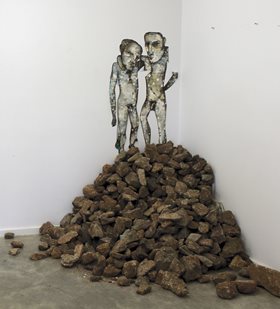-(1).aspx) The Art of the Long Conversation
The Art of the Long Conversation
Antony Muia by Sheridan Coleman
In 1977, NASA launched Voyager 1, a deep space probe destined to gather information about our solar system on a non-stop, one-way cruise into the universe. Aboard its 36-year-and-counting flight is a curious cargo: a facsimile of Leonardo Da Vinci’s Vitruvian Man. While it’s no surprise NASA chose the hero of our renaissance to represent us, it is revealing to note that it was an artwork, and not a documentary photograph, that was chosen to explain what a human is; to whomever or whatever might eventually get their tentacles on that capsule.
The role artistic invention plays in helping people conceive of themselves as humans also drives artist Antony Muia. Over 20 years of practice, Antony has worked exclusively with human figures, using his highly distinct style, with its lopsided, linear irregularity. However, he is no portrait painter,
“I like to think that my images show us the way that aliens would see us,” Antony explains. “I hope they are examples of typical humans with all their foibles.”

Riffing on this one subject for so long has been an exhaustive process during which the need to depart from the ‘universality’ of figure painting has never arisen. “My pictures haven’t changed a lot in 20 years,” he says. “In some ways I’ve been doing the same image over and over. I’m okay with that.” Unlike the perfect ratios of the Vitruvian body, Antony champions our imperfections, proliferating image after image of unusual bodies caught in trying, vulnerable moments.
Such a focused practice necessitates plenty of repetition, something Antony has begun to feature explicitly in his work. “There’s a lot of menial practice, just moving stuff around, that goes into making anything, art included.” Daylighting as a stonemason, Antony has a Zen-like appreciation for such monotony. His recent figure works are pasted above stacked rocks that he assembles on the gallery floor. The piles become stepping stones between the viewer, the 2D works and the gallery space. “I wanted a pile of rocks. It’s hard to pile up rocks and still make it look like a pile of rocks,” Antony quips, typically negotiating both erraticism and deliberation.
Despite working with models as a form of research, Antony rarely paints from life. Instead his figures are built up on the page in a succession of brushstrokes.
The artist suspects that immersing himself in picture books as a child gave him a feel for inventing believable worlds. “I would feel connected to a place or time that I couldn’t be a part of. I try and emulate that.” Indeed, Antony’s figures are captivating, caught in moments of indiscretion, intimacy, reverie or tension. His world is one of unnamed narratives and nonsense-places, somehow populated with characters that are nonetheless credible. Perhaps the artist is slowly recreating the human race in diorama, playing out all our tics and tendencies. We also learn that our oddities can turn from unique occurrences into examples of an expected ratio of cases-per-capita: into ‘normalcy’.
When compelled, Antony diffidently suggests the theme ‘human predicament’ as a key to his work, despite the wonderful acuity of such a phrase. “I think I’m drawn to difficult subjects, stuff I don’t understand,” he says. In making no aesthetic concession, it is clear Antony’s goal is to make honest, vital images and leave it at that.
Sheridan Coleman is an artist and arts writer living in Fremantle, WA. She is currently completing a PhD at Curtin University, investigating the impact of imaging technologies on the way landscape artwork is created and received.
This article featured in the Artsource Newsletter, Summer 2013.